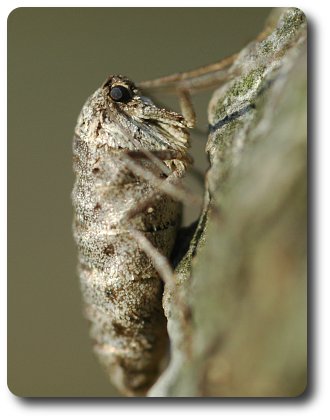January is a rather bleak time for entomologists. The warmth of the summer is just a memory and spring is still months away. Bug activity outdoors is generally low. Imagine our delight last week on a warm day in January when we had the good fortune to discover several female fall cankerworms resting on a maple tree. These little gals are remarkable moths who have lost their ability to fly. Is this some unfortunate twist of fate or the curse a malevolent sylvan fairy? Perhaps, but many entomologists believe that the cankerworm has found a clever way to leave more offspring behind. By shifting bodily resources from equipment needed for flight such as wings and muscles to flap them, and redirecting these resources to the production of eggs, the female cankerworm may be able to bring more little caterpillars into the world and enhance her lineage’s odds for survival. Regardless of the reason underlying the mystery of the wingless moth, cankerworms are a wonder to see.
The fall cankerworm male is a good flyer and follows a scent trail to find his mate.
Beginning in late autumn, adult fall cankerworms emerge from their pupal cases in the soil. The females move from the soil and climb vertical structures such as trees and buildings. Shortly after sunset, on warm winter nights, female moths release a chemical signal called a sex pheromone that attracts the male moths. The fall cankerworm males have functional wings and are good fliers. Each male tracks the pheromone to its source and the chilly couples mate. After this interlude, females climb high into the tree and place their eggs on the bark. Females do not live to see their offspring.
The female fall cankerworm lacks functional mouthparts and does not eat.
Unlike other species of moths that have tubular mouthparts used to sip nectar, the female fall cankerworm lacks functional mouthparts. She cannot feed and shortly after depositing her eggs, she dies. The larvae of fall cankerworms hatch early in the spring shortly after buds of the trees open and young leaves appear. These green or brown caterpillars drop from leaves on strands of silk when disturbed. Caterpillars of fall cankerworms and other members of their clan are also known as inchworms or loopers. They have multiple legs on their front and rear ends. By alternating their grasp between front and rear legs and bending their body into a loop they move along twigs as if measuring the world an eighth of an inch at a time. The name cankerworm derives from the shredded, cankered mess caterpillars make of plant leaves as they feed. Their larvae reach phenomenal numbers in some locations and years and devastate many shade trees such as oaks, maples, elms, and lindens. In addition to the fall cankerworm, other members of their clan such as the spring cankerworm and linden looper are active in the winter and have flightless females. A close relative of the fall cankerworm called the winter moth has recently appeared in the cities and suburbs near Boston where it is wreaking havoc.
References:
For more information of cankerworms and winter moth, please visit the following web sites.
http://ohioline.osu.edu/hyg-fact/2000/2558.html
http://www.umassgreeninfo.org/fact_sheets/defoliators/wm_id_man.html


